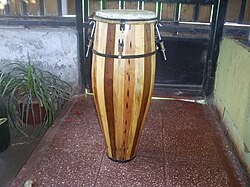Atabaque
This articleneeds additional citations forverification.(January 2013) |
 | |
| Percussion instrument | |
|---|---|
| Classification | Membranophone |
| Hornbostel–Sachs classification | 211.221.1 (Barrel drum) |
| Developed | Brazil |

Theatabaque(UK:/ˌætəˈbæki/AT-ə-BAK-ee,US:/ˌɑːtəˈbɑːki/AH-tə-BAH-kee,Brazilian Portuguese:[ataˈbaki]) is a tall, wooden, Afro-Brazilianhand drum,similar toconga.[1]
The shell is made traditionally ofJacarandawood fromBrazil.Theheadis traditionally made from calfskin. A system of ropes are intertwined around the body, connecting a metal ring near the base to the head. Because of this tuning mechanism the drum is sometimes known as 'Atabaque de Corda'. Wooden wedges are jammed between this ring and the body and a hammer is used to tighten or loosen the ropes, raising or lowering the pitch of the drum.
In Africa, cord-and-peg tension atabaques had a distribution area roughly congruent with the iron double bell (Agogo). This included the Guinea Coast from the Niger River and west to Benin, Togo, and Ghana. Beyond West Africa, cord-and-peg tension drums appeared in Bahia, Suriname, St. Domingue, Cuba, and the southern states of America. These drums traveled with theEwe,Fon,Akan,andYorubapeople during the New World diaspora.[2]
The atabaque is used inCapoeira,Maculelêand the Afro-Brazilian religions ofCandombléandUmbanda.It is considered sacred inCandombléandUmbanda.The main instrument in Candomblé is the drum (Atabaque), skinned with cord-and-peg tension.[2]
There are three types of atabaque:rum,the tallest with the lowest pitch;rum-pi,of medium height and in the middle pitch range; andlê,the smallest and highest-pitched.[3]
InMaculelêand the rituals ofCandombléandUmbanda,as many as three Atabaques are used (usually one of each type), but inCapoeira,traditionally only one is used.
Nomenclature
[edit]The atabaque has several distinct parts. Some of these are the couro de boi (oxhide), the corda (rope) and the aro (hoop), forming where together the corda de aro (rope hoop). The acunhas are the Wedges, and the suporte is the atabaque stand.
Literature
[edit]- Capoeira, Nestor (2007).The Little Capoeira Book.Blue Snake Books.ISBN9781583941980.
References
[edit]- ^Capoeira 2007,pp. 8.
- ^abTaylor, G. Capoeira: The Jogo de Angola from Luanda to Cyberspace (2005)
- ^Almeida, B. Capoeira: A Brazilian Art Form: History, Philosophy, and Practice.(1993)
